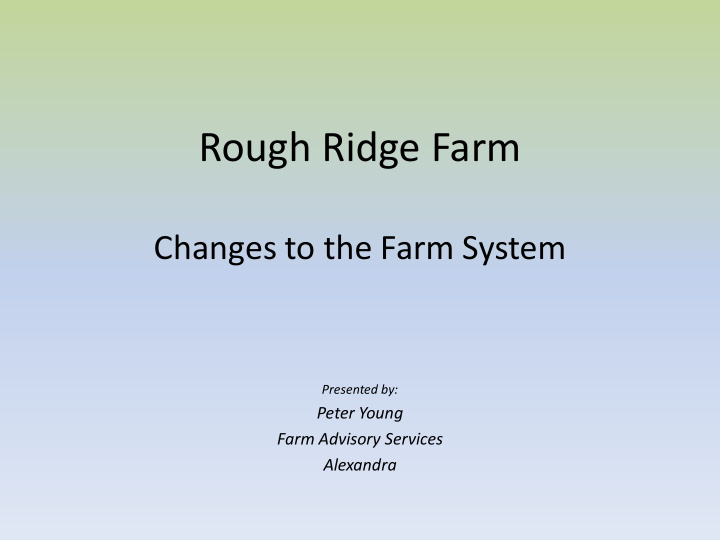



Rough Ridge Farm Changes to the Farm System Presented by: Peter Young Farm Advisory Services Alexandra
Why Examine the System? • Farm within limits outside our control - system needs to fit • Production & Efficiency of Production - feed supply / demand fit - kg product / kg DM eaten - cost of production - profitability
Starting Rough Ridge Farm Model Heavy reliance on ryegrass dominant pastures Separate X bred paddock ewe flock Stock performance hindered by summer feed supply & quality Hill used as a relief valve for the paddocks Lucerne priority to supply supplements Winter brassica crops - unreliable strikes & yields Difficulty growing out young replacement stock Poor establishment of permanent pasture Irrigation water supply unreliable from January
Starting Land Utilisation Irrigable ryegrass based pasture – 155 hectares Dryland pastures - 75 Lucerne - 28 Summer crop - 16 Winter Crop - 26 Annual Growth Assumptions (kg DM / ha) Irrigable Pasture: 6,400 Dryland pasture: 2,450 Lucerne: 5,150
Rough Ridge Model Changes Replace dryland ryegrass pastures with lucerne - Productive – minimum of twice annual production of ryegrass pastures - Improved feed quality throughout the season - More persistent - savings in renewal costs
Comparative Dry Matter Production* 300000 250000 200000 150000 Old Model New Model 100000 50000 0 *Annual growth assumptions: (kg DM / ha) Irrigable pasture 6,400 Dry pasture 2,450 Lucerne 5,150 Total projected increase of 300,000kg DM (+28%)
“ The Terrace ” 4 year old pasture 18 th Feb 2010 Growth after 76mm rain in early January = 286kg DM / ha
“Old Horse Lucerne” 18 th Feb 2010 Growth after 76mm rain early January = 2070kg DM / ha
Reduce reliance on summer crops - Summer rape to be phased out - Reduction in renewal costs Create more flexibility in paddock stocking model - Need to fit the stock model to lucerne – not the reverse - Remove X breds from paddocks and replace with AD ewes - Reduce summer feed demand to create more feed for hill lambs - Flexibility for hill ewes to come onto paddocks pre-weaning - Introduce cattle to the mix – complimentary effect
Changes to Available Grazing Area 300 250 200 150 Old Model New Model 100 50 0
Changed Land Utilisation Irrigable ryegrass based pasture – 155 hectares Dryland pastures - 30 Lucerne - 81 Summer crop - 10 Winter Crop - 24
Focus on growing out replacement stock - More emphasis on ewe hogget feeding - No longer put up the top of the hill in summer - Take priority over finishing lambs Target minimum feed covers at crucial times - Spring and autumn feed target covers now a focus - Once over winter rotation - Winter feed budgeting - Pro-active pasture management
Focus on feed quality and stock feeding levels - Improved lamb growth rates – saving feed - Better ewe condition - Minimise fluctuation of ewe liveweights Use lucerne more in the grazing system - Utilise lucerne early to optimise lamb growth pre-weaning - Make more supplements from irrigated pasture
Use irrigation water strategically to secure pasture & crop establishment - Utilise a portable spray irrigation system for strategic use - More confident sowing crops and pastures Utilise suitable sites for on farm water storage - Two small storage dams constructed - More planned - Have one winter crop within reach of a dam each year
Strategic Irrigation ROI Capital Invested: Pump & Lines $15,000.00 Depreciation: 12% per annum SL 1,800.00 Interest: 9% per annum 1,350.00_____________ Total Indirect Costs $3,150.00
Irrigate 15 ha Brassica Irrigate 2.25 ha / 24 hours x 3 irrigations = 480 hours Irrigate 15 ha New Permanent Pasture Irrigate 2.25 ha / 24 hours x 1 irrigation = 160 hours
Pumping Costs: Fuel: 640 hours x 2.5 litres / hour x $1.15 / ltr = 1,840.00 R & M: 640 hours x .50 / hour 320.00 Shifting: 53 shifts x 30 min + 20 hours x $30 / hr = 1,400.00 Lost Production: 15 ha x 15:1 response x .10c / kg DM 4,500.00_____________ Total Direct Costs $8,060.00 Total Annual Costs: $11,210.00
Income Winter Brassica: 15 ha x 30:1 response 4,500kg DM x .15c = 10,125.00 Young Grass: Seed & preparation x $300 /ha = 4,500.00 Spring Feed: 15 ha x 2,000kg DM x .15c = 4,500.00___________ Total Savings / Income $19,125.00 Potential Return on Investment = 53%
Recommend
More recommend